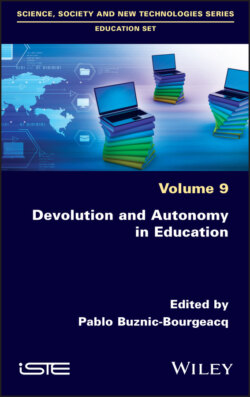Читать книгу Devolution and Autonomy in Education - Группа авторов - Страница 18
1.2.2. The work of the teacher and the activity of the devolving subject
ОглавлениеOnce the analysis of the objects of devolution has begun, once the researcher knows a little more about what the aim of the responsibility required, a research space appears particularly well illustrated by the concept of devolution: the work of the teacher, in other words, the activity of the devolving subject. Understanding the conditions, constraints, modalities, opportunities and difficulties that structure the processes of devolution allows us to better grasp the foundations of the professional activity of teaching. As Maël Le Paven and his collaborators point out with regard to the conceptual filter of devolution, “certain events or behaviors in the classroom would otherwise remain unseen” (Le Paven et al. 2007, p. 9). For the concept carries with it its paradox: it seeks to analyze the activity of a subject who fades away, it aims to capture a form of absence where presence is at its peak, and it aims at the activity of a mediator rather than the passivity of an actor. We will then first agree on the focal point induced by the concept: “the question of devolution is posed more on the teacher’s side” (Amade-Escot 2006, p. 96) and with it “it is indeed the teacher’s activity, within the didactic situation, that is at issue” (Zaragosa 2006, p. 418). Devolution will even constitute one of the four pillars of the structure of the didactic action of the teacher, alongside the activities of definition, regulation and institutionalization (Sensevy 2007). In short, the concept of devolution is above all a way of rethinking the work of the teacher in action and is thus notably different from the concept of transfer. If the analysis of learners’ activity is inevitably necessary to understand the phenomena of devolution, as a concept, it invites us to enter the didactic system through the work of the teacher, through what the latter does so that the former can act together.
We can then agree on another perspective: the concept describes a paradox, a tension, a tug of war that testifies to the subtlety of this work. For its aim is indeed to “make people accept” and, moreover, to make people accept something that is no less important, a “responsibility”. By remembering that “all responsibility refers to the experience of the impossible” (Hubert and Poché 2011, p. 28), we will come face to face, with the question of devolution, with the impossibility that is the basis of the teaching profession, itself already widely described since Sigmund Freud did so (1937) and subtly problematized by a few more contemporary thinkers attached to questions of autonomy (Castoriadis 1990; Cifali 1999; Descombes 2004). Being responsible for the other’s responsibility is a particularly delicate situation that is a sign of teaching professionalism. More precisely, for Guy Brousseau, the concept of devolution originates in the challenge of the teacher in the face of this delicate situation, a challenge that the tutor takes up in order to found his or her object:
We don’t see how we could summon the subject. The teacher has Gaël in front of him and Gaël is not there. He has to commit himself personally to what he knows or does not know […]. It is necessary to unshackle him from this attitude, and this must depend on the conditions and the situation, not only on a personal evolution (Brousseau 2006, p. 410).
Faced with the consistency of such a challenge, we must then measure the extent of the teacher’s work as understood in relation to the concept of devolution. It does not simply consist of analyzing the moment when the teacher, faced with his or her students, having defined the constraints of the situation in which he or she wants them to act, asks them to take responsibility for their learning. It is not simply a matter of thinking, constructing and analyzing a task that is engaging for the students. The challenge is to analyze an entire process that organizes the transfer of responsibilities. Claire Margolinas’ work on the issue of devolution allows us to grasp this scale of analysis:
Devolution, as a process, and not as a fleeting moment in the teacher’s activity, encompasses both what allows the student to accept the problem, what allows this acceptance to continue, but also what allows the student to produce his or her response, and to recognize the effects of this production […]. Class work is only the most visible part of his or her professional activity. The knowledge that we are looking for will therefore relate to a situation of which the intervention phase in class is only one element (Margolinas 2006, p. 331).
With its objects, the devolution invites us to think about its spaces and temporalities in all their extent. This is also what this book proposes, and most of the chapters present a study of devolution on a large scale, well beyond a specific situation. For example, Florian Ouitre questions devolution in the field of teacher training. He sees it in a complex way, as an embedding of problematization processes, where the devolution of the problem oscillates in a game of small and large loops, between its position, its reconstruction, its resolution and its socialization. In the same field, but from a different approach, Bruno Hubert questions a whole professional writing system in which storytelling, narration, fictionalization and sharing with peers constitute a complex space of devolution deployed over a consequent tempo.
